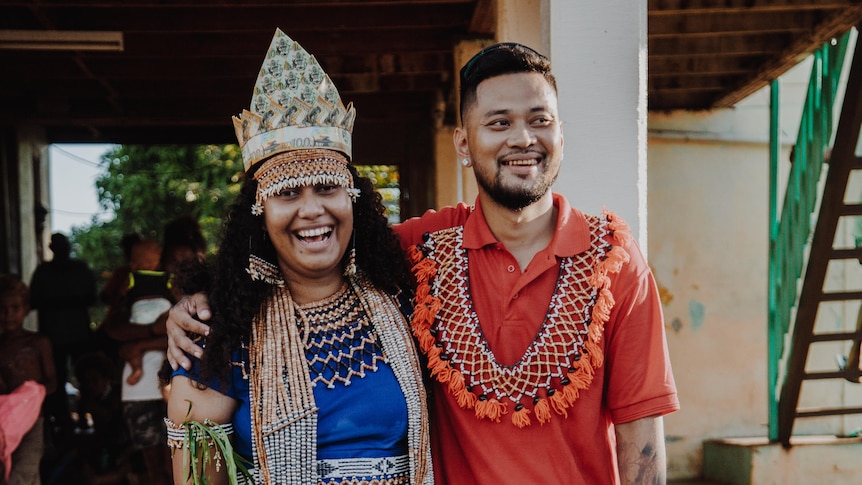Strings of seashells, coils of red feathers and dolphin teeth are traditional currencies that are used to say “I love you” in parts of the Solomon Islands.
The shells play a significant role in traditional bride price ceremonies, which are used to mark when a woman leaves her family to settle with her husband.
But for Australian-based Solomon Islander Terry Wong, tracking down the shell money for his bride-to-be — my sister Azalea — was no easy feat.
For generations, strings of shells have been used to trade and settle disputes, long before cash was introduced.
Shell money is still used in provinces including Malaita, Makira and Guadalcanal and families often have a treasure box of the currency hidden in their homes.
Solomon Islands is home to a range of traditional currencies, and some are easier to find than others.
Some provinces use large disc-shaped clam shells called “bakiha”, while others use dolphin teeth or red feather money.
While the red feather money from Santa Cruz Islands in the eastern part of the country is no longer in use after the small scarlet honeyeater bird became difficult to find, dolphin teeth and shell money are still commonly used.
To create shell money, the seashells are broken, smoothed and collected in strings of 10 to form a “tafulia’e”.
The different lengths of string have different value and a single tafulia’e can be worth anywhere between $100 and $500.
Dancing, music and shouting on the big day
On the day of the bride price ceremony, Terry and his family arrive at our home in Honiara in a convoy of vehicles to a chorus of tooting horns, laughing and shouting, and we welcome them with plenty of music and dancing.
It’s a big deal for Azalea’s loved ones, who have come out in large numbers to witness her bride price and farewell her with traditional dances.
Terry’s family bring items to pay the bride price: live pigs, bags of rice, root crops, traditional mats and a small black box of shell money — the most valuable item of all.
“It was a hard time [finding the shell money] but we just endured it,” Terry says.
“It’s for someone I love and also, as shown today, my family loves her too.”
Terry’s family is from the province of Temotu in the eastern part of the Solomons. It’s closer to Vanuatu and shell money isn’t part of their culture.
Terry’s grand uncle Solomon Palusi says finding the shell money was “very difficult but wasn’t impossible.”
“We tried our very best to take the shell money.”
It’s for people like Terry that a shop has recently opened in Honiara’s Chinatown, selling shell money for cash, targeting three of the nine provinces in the country that use the traditional currency.
Why is shell money so hard to find?
Shell money shop owner Mary Sifoburi is from Langa Langa in Malaita province, a community known for crafting the currency.
“Basically, the process of making shell money involves 10 steps before the product comes to completion,” Mary says.
The shells are smoothened and ground flat before a small drill is used to create a hole in the center of the shell, and a tuna tin is used as a makeshift scale to weigh them.
“In the past it would take two to three days because of the manual drill used. But now with the introduction of the new drill, a person can drill three to four tins [worth] per day,” Mary says.
The shells are placed on hot rocks to change color before final grinding is done.
It’s not an easy task and it can take up to two weeks to find a single shell.
“There are different kinds of shells involved in the process of shell money, so we have black shells, white shells and red shells,” Mary says.
The harder the shell is to find, the higher the value.
“For now, I can say that the value is based on the people who produce the shells but because right now… we do not have any standard regulations to guide the value of the shells, the prices vary,” she says.
Concerns currency will fall out of circulation
Father of the bride Steve Aumanu has noticed the monetary value of shell money shift over the decades but the cultural value has so far endured the test of time.
“It’s being commercialized, the value of the shell is called by those who produce it and those who are price takers, we don’t have much choice,” he says.
With shell money now so difficult to find and its price increasing, community elders fear it will some day lose its place in the three provinces.
“I don’t know whether it will cease to be recognized but for the time being, the value has been ascending,” Steve says.
Back at the bride price ceremony, the bride stands with her cousins on traditional mats called “kaufe”, which in the Malaitan custom recognizes her leaving her family home with dignity and pride.
An honoring ceremony of Azalea’s closest aunties and grand aunties also takes place where the groom’s side hands over monetary gifts in red envelopes that reflect Terry’s father’s Chinese heritage.
The moment of truth
The most anticipated part of the ceremony comes when the bride’s father either accepts or declines the bride price from the groom’s side — there have been instances where it has been rejected.
But not this time around.
During the ceremony, more than 20 tafulia’e are given to the bride’s father by the groom’s father.
“Traditionally when there’s a marriage ceremony between two people, that’s a significant event in the life of a family or tribe and this one is no different,” Steve says.
“When we are all together to witness, it’s a manifestation of a great valuable cultural undertaking.”
And on the occasion of my sister’s bride price ceremony, the enduring value of the shell money and the traditions that come with it, are clear.
.
